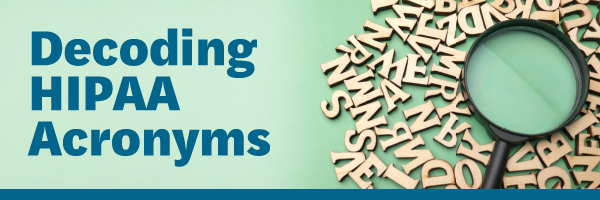
You started your healthcare business with a passion for making a difference in people’s lives. However, amidst the rewarding work of providing care, the administrative and regulatory aspects of running a practice can feel overwhelming. Understanding the intricacies of HIPAA compliance can be a daunting task, but it’s a crucial one for safeguarding the trust of your patients. We’re here to help you on your impactful mission. So, our team of compliance experts compiled a list of our top HIPAA acronyms and definitions to know.
The ABC’s of H-I-P-A-A
Business Associate
Companies that provide services to covered entities involving access to patient information. Business associates must also comply with HIPAA rules when handling protected health information (PHI).
BAA
A Business Associate Agreement is a written contract between a HIPAA-covered entity and a business associate that establishes the permitted and required uses and disclosures of protected health information (PHI) by the business associate. It also outlines the safeguards that the business associate must implement to protect the privacy and security of the PHI.
Covered Entity
Healthcare providers, health plans, and healthcare clearinghouses that transmit health information electronically. Covered entities must follow HIPAA rules to protect patient data.
EHR/EMR
Electronic Health Record/Electronic Medical Record are often used interchangeably to refer to a digital record of a patient’s health information, with EMRs typically limited to a single healthcare organization and EHRs designed for interoperability and data sharing across the healthcare system.
ePHI
Electronic Protected Health Information refers to any individually identifiable health information that is created, stored, transmitted, or received in electronic form.
HHS
The U.S. Department of Health and Human Services oversees healthcare-related federal agencies like OCR and develops HIPAA regulations.
HIPAA
The Health Insurance Portability and Accountability Act is a federal law that sets standards for protecting sensitive patient health information that Covered Entities and Business Associates must follow.
HITECH Act
The Health Information Technology for Economic and Clinical Health Act promotes the adoption of health information technology and strengthens HIPAA provisions on data privacy and security.
NIST
The National Institute of Standards and Technology, which develops cybersecurity standards and guidelines that HIPAA covered entities must follow for the Security Rule.
OCR
The Office for Civil Rights, a division of the U.S. Department of Health and Human Services (HHS) that enforces HIPAA compliance and can investigate complaints and conduct audits. They are currently in a period of random auditing.
Privacy Rule
One of HIPAA’s 4 rules. Establishes national standards for protecting individuals’ health records and other personal health information. It controls how PHI may be used and disclosed.
Security Rule
Another of HIPAA’s 4 rules. Outlines administrative, physical, and technical safeguards that covered entities and business associates must implement to ensure the confidentiality, integrity, and availability of electronic PHI.
A Path Towards a More Secure Future
By taking the time to demystify and better understand HIPAA acronyms and terminology, you demonstrate an unwavering commitment to upholding the privacy and well-being of those who have entrusted you with their care. Mastering HIPAA literacy is the first step towards a more secure organization for you, your employees, and your patients.

Leave a Reply